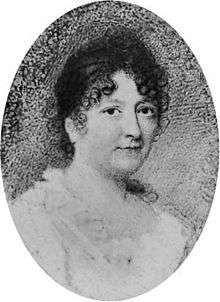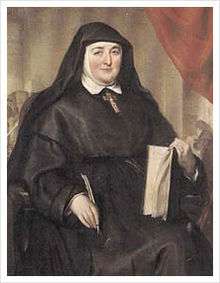Mary Aikenhead
| Mother Mary Frances | |
|---|---|
 Mary Aikenhead (ca. 1807) | |
| Born |
19 January 1787 Daunt's Square, Cork, Ireland |
| Died |
22 July 1858 Our Lady's Mount, Harolds Cross, Dublin, Ireland |
| Resting place | St. Mary Magdalen's, Donnybrook, Dublin, Ireland |
| Known for | The founder of the Religious Sisters of Charity |
| Religion |
Roman Catholicism (1802–1858) prev. Anglican Communion (1787–1802) |
| Parent(s) |
David Aikenhead Mary Stacpole |
Mother Mary Frances Aikenhead (19 January 1787 – 22 July 1858) was born in Daunt's Square off Grand Parade, Cork, Ireland. She was the founder of the Catholic religious institute, the Religious Sisters of Charity, and of St. Vincent's Hospital in Dublin.
Biography
The daughter of David Aikenhead, a physician, member of the Anglican Church of Ireland, and Mary Stacpole, a Roman Catholic. Her grandfather, also named David Aikenhead, was a Scottish gentleman who relinquished his military profession, married a Limerick lady, Miss Anne Wight and settled in Cork.[1] Mary was baptised in the Anglican Communion on 4 April 1787. Mary was quite frail and probably considered to be asthmatic and it was recommended that she be fostered with a nanny called Mary Rourke who lived on higher ground on Eason's Hill, Shandon, Cork. It is thought that Mary was secretly baptised a Catholic from this early age by Mary Rourke who was a devout Catholic. Her parents would visit every week until 1793 when her father decided he wanted her to rejoin the family in Daunt's Square.[2] The Rourkes also joined the family and worked as servants to the family.[3]
By the early 1790s Dr. Aikenhead had become imbibed by the principles of the United Irishmen. On one occasion Lord Edward Fitzgerald disguised as a Quaker sought refuge in the Aikenhead home. He was enjoying dinner with the family when the house was surrounded by troops with the sheriff at their head. The visitor managed to disappear and reach safety across the river. The house was searched but because of the loyalty of his apprentices who knew and kept the doctor’s secret, no incriminating documents were found.[1]
She was aged 15 when she was officially baptised a Roman Catholic on 6 June 1802, a time after the death of her father on 15 December 1801, who had himself been received into the Roman Catholic Church on his death-bed.[2][4]
In 1808, Mary went to stay with her friend Anne O’Brien in Dublin. Here she witnessed widespread unemployment and poverty and soon began to accompany her friend in visiting the poor and sick in their homes.[5]

Accustomed as she was to an active life of charity, and feeling called to the religious life, she looked in vain for a religious institute devoted to outside charitable work. She was chosen by Archbishop Murray, Bishop Coadjutor of Dublin, to carry out his plan of founding a congregation of the Sisters of Charity in Ireland, and in preparation for it made a novitiate of three years (1812–15) in the Convent of the Institute of the Blessed Virgin at Micklegate Bar, York.[5] She there assumed the name she kept till death, Sister Mary Augustine. `
On 1 September 1815, the first members of the new institute took their vows, Sister Mary Augustine being appointed Superior-General. Added to the traditional three vows of poverty, chastity and obedience, was a fourth vow: to devote their lives to the service of the poor.[5] The following sixteen years were filled with the arduous work of organizing the community and extending its sphere of labor to every phase of charity, chiefly hospital and rescue work.
In 1831 overexertion and disease shattered Aikenhead's health, leaving her an invalid. Her activity was unceasing, however, and she directed her sisters in their heroic work during the plague of 1832, placed them in charge of new institutions, and sent them on missions to France and Australia.[6]
Mary Aikenhead was the foundress of St. Margaret's Hospice, as it has been known since 1950, has changed its name to St. Margaret of Scotland Hospice.[7]
She died in Dublin, aged 71, having left her institute in a flourishing condition, in charge of ten institutions, besides innumerable missions and branches of charitable work.[6] She is interred in the cemetery attached to St. Mary Magdalen's, Donnybrook.[2]
Heritage centre
The Mary Aikenhead Heritage Centre details Mary's life and the Religious Sisters of Charity. It is located at Our Lady's Hospice, Harolds Cross in the building called Our Lady's Mount.[8] This is where Mary Aikenhead spent the remainder of her life. The building was later used to establish Our Lady's Hospice in 1879.
Cause for canonization
Her cause for canonization as a saint has been progressing in Rome. On 18 March 2015, a decree was issued proclaiming her heroic virtues. This entitles her to be referred to as the Venerable Mary Aikenhead.
See also
| Wikimedia Commons has media related to Mary Aikenhead. |
References
- 1 2 Twohig RSC, Miriam. "A Short Synopsis of the Life of Mother Mary Aikenhead"
- 1 2 3 Blake, Donal S. (2001). "Mary Aikenhead Servant of the Poor", Religious Sisters of Charity
- ↑ "Our History". Retrieved 15 September 2016.
- ↑ Entry at Princess Grace Irish Library
- 1 2 3 "Mary Aikenhead", Mary Aikenhead Ministries
- 1 2 "CATHOLIC ENCYCLOPEDIA: Mary Aikenhead". Retrieved 15 September 2016.
- ↑ "St. Margaret of Scotland Hospice". http://www.smh.org.uk. External link in
|publisher=(help) - ↑ "rscmaheritage.com". Retrieved 15 September 2016.
| Wikisource has the text of the 1885–1900 Dictionary of National Biography's article about Mary Aikenhead. |